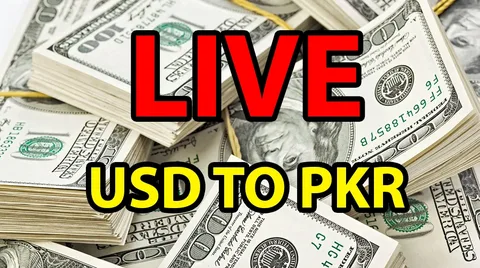Keeping track of how much 1 USD converts to PKR is essential in today’s world of global trade, remittances, freelancing, and overseas education. Whether you’re a business owner calculating costs, a freelancer converting earnings, or a parent sending money abroad, understanding the latest market rate and trends gives you the insight needed to maximize value.
What Is the Latest Market Rate for 1 USD to PKR?
Currently, the 1 USD to PKR exchange rate ranges between ₨ 282.5 and ₨ 285, depending on whether you’re looking at the interbank (official) rate or open-market (retail) rate.
- Interbank rates—used by banks and large institutions—are typically lower and more stable.
- Open-market rates, offered through exchange companies, may include small markups.
Despite daily volatility, the rate generally stays within a narrow band, reflecting a mix of economic fundamentals and market sentiment.
Why This Rate Matters
Even a small fluctuation of one or two rupees can make a huge difference:
- Freelancers converting $1,000 might see a difference of ₨ 2,000–3,000 in total earnings.
- Importers paying in USD could save or lose tens of thousands, depending on the rate timing.
- Remittance receivers feel the impact directly in household budgets.
- Students and travelers may reduce expenses by converting strategically.
Understanding rate shifts allows for educated conversion decisions.
Key Trends Driving the Exchange Rate
1. Market Supply & Demand
High demand for USD—in trade, debt servicing, or speculation—drives the exchange rate up. Increased supply, from remittances or exports, can lower it.
2. Inflation Rates
Higher inflation in Pakistan compared to the U.S. erodes PKR value, requiring more rupees per dollar.
3. Central Bank and Government Action
Policy changes such as interest rate shifts or currency interventions support the rupee or allow depreciation. Recent government crackdowns on illicit exchange channels also help stabilize the rate.
4. Trade Balance
A trade deficit—more imports than exports—places upward pressure on the USD to PKR rate.
5. Foreign Inflows and Reserves
Remittances, foreign investment, and foreign exchange reserves are critical in determining rupee strength.
6. Global Dollar Momentum
When the dollar strengthens globally, especially against emerging market currencies, it puts upward pressure on the PKR irrespective of local conditions.
Historical Movements: What the Numbers Show
Recent trends reveal:
- Rates oscillate between ₨ 282 and ₨ 285.
- A 30-day range might show an average around ₨ 284.3, with peaks at ₨ 285 and lows near ₨ 282.6.
- Short bursts of volatility often align with policy announcements, global events, or abrupt shifts in remittance flows.
Tracking these trends helps anticipate potential windows for favorable conversion.
Real-Life Scenarios—How Differences Add Up
Freelancing Income:
$1,500 at ₨ 283 = ₨ 424,500
$1,500 at ₨ 285 = ₨ 427,500
→ A difference of ₨ 3,000 due to just 2 rupees per dollar.
Import Costs:
Importing goods worth $20,000:
- At ₨ 283: ₨ 5,660,000
- At ₨ 285: ₨ 5,700,000
→ That’s ₨ 40,000 difference in total landed cost—impactful for business planning.
Tools to Monitor Daily Rate Changes
- Real-Time Currency Trackers
These show live USD to PKR rates, updated continuously throughout trading hours. - Rate Alerts
Apps allow setting trigger alerts when the rate reaches your target conversion level. - Multiple Platform Comparison
Check interbank, digital, and open market rates before deciding. - News Monitoring
Follow policy news, major economic updates, and forex reserve status to anticipate sudden shifts.
Interbank vs. Open Market: What You Should Know
| Rate Type | Typical Value | Best For |
| Interbank | ₨ 282.5 – ₨ 283.5 | Large transfers via banks |
| Open Market | ₨ 283.5 – ₨ 285+ | Retail exchange & remittances |
Most currency apps reflect interbank rates, while real-world exchange houses operate closer to open-market values. Knowing the difference helps you make more accurate decisions.
What Experts Forecast for the Future
- If inflation eases, reserves stabilize, and remittances increase—expect the USD to PKR rate to hover around ₨ 283 to ₨ 284.
- If forex pressure continues, and global USD remains strong—rates could push up toward ₨ 286 or higher.
- Government policy, economic reforms, IMF engagement, and export growth will all influence trajectory over the coming months.
Tips for Smart Conversions
- Monitor daily rates and avoid impulsive conversions.
- Choose reputable sources—international apps, established banks, and licensed exchange houses.
- Delay conversions if short-term improvement is anticipated.
- Set up rate alerts for automated notifications.
- Diversify currencies when possible to hedge risk.
Final Thoughts
Understanding how much 1 USD is worth in PKR today and the reasons it changes is more than being informed: it’s about making smart financial choices.
Whether you’re transferring earnings, importing goods, paying overseas expenses, or budgeting remittances, the latest USD to PKR rate impacts your bottom line. By staying alert to trends, using trusted tools, and timing conversions wisely every rupee counts in today’s shifting currency landscape.
FAQS:
1. What is the current exchange rate for 1 USD to PKR?
The rate fluctuates daily based on market trends. As of now, 1 USD typically ranges between ₨282 to ₨285 in the open market. Always check a reliable source for the most up-to-date rate.
2. Why does the USD to PKR rate change every day?
The exchange rate varies due to multiple factors such as inflation, trade deficits, global currency trends, interest rates, and market demand for dollars. These fluctuations are part of normal forex activity.
3. What is the difference between the interbank and open market rate?
-
Interbank rate: Used between banks and large financial institutions; usually lower.
-
Open market rate: Used by currency exchange companies for retail; slightly higher due to added margins.
4. Where can I check the real-time USD to PKR rate?
You can use financial apps, online forex calculators, or check with licensed currency exchange providers in Pakistan. Avoid unofficial sources that may provide inaccurate data.

